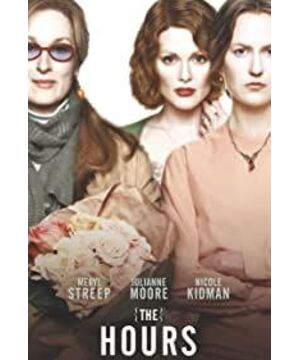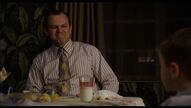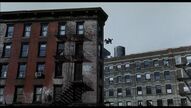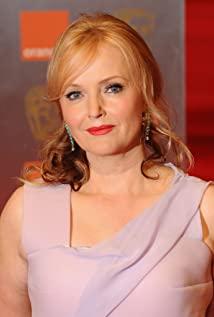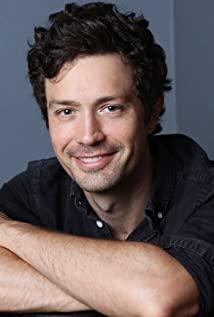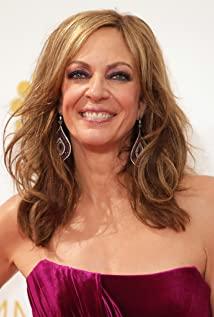's
"The Hours" is a movie with deep soul and intriguing rhythm like string music.
The film is notable because it has a different text-a wonderful novel. The film is more faithful to the original. I firmly believe that the director Stephen Daldry deeply understood the rich meaning behind the original work and tried to fully express it when shooting, so that the film has a brilliant and outstanding quality.
The film is based on the novel of the same name published in 1998 by the emerging American writer Michael Cunningham. The novel "The Hours" (whether film or novel, the translation of "The Hours" is very inconsistent. Novel: The first edition of Taiwan Xidai Book Publishing Group in June 2000, translated as "Time Moments", translator Cai Minsheng; Mainland China Translation Forest The first edition of the publishing house in April 2002, translated as "Liying Ping Zong", translator Liu Xinmin. Movies: translated titles include "Song of Years", "Elegy of Years and Years", "Now and Now", "Time and Moment", etc. For the convenience of discussion, it is called "The Moment".) Immediately after publication, he won the "PEN/Faulkner Award" (The PEN/Faulkner Award), and the "Pulitzer Prize" (The Pulitzer Prize) the following year. ).
So, what kind of novel is this, and why is it so popular?
The second
novel ostensibly tells the spiritual life of three women in different eras in the 20th century.
The suburbs of London in 1923. Virginia Woolf conceived the novel "Mrs. Dalloway" in her country house, which was far from the taste of the Victorian era. Early in the morning, she didn't get up immediately after waking up, her expression was in a daze, and the headache that had been entangled her slightly improved. There are birds calling outside the window. She felt fatigued, lost her mind, and took a nap in a daze. In her dream she found herself in a garden. Flower, it's good to start a novel with flowers. She thought when she woke up. She got up and walked into the bathroom, facing the gray face reflected in the bathroom mirror, unavoidably dejected. It is in sharp contrast with the image in the mind.
Los Angeles, USA in 1949. Mrs. Brown reads Wu Erfu's "Mrs. Dalloway" at home. She has a loyal husband, a sensitive and lovely son, and everything seems to be impeccable. But she still feels bored in every way and suffers from being trapped in a mediocre family life. This day was her husband’s birthday, but she had no intention of preparing a cake for the evening’s birthday celebration. She wanted to hide in a hotel and read "Mrs. Dalloway" in bed like Wu Erfu, and then committed suicide. She entrusted her son to a neighbor. At the moment of saying goodbye, the sensitive child seemed to have a foreboding. She anxiously told her mother to come and pick him up, and chase after her mother's car...
New York at the end of the 20th century. A female editor named Clarissa is going out to buy flowers. Because her name is the same as the protagonist Clarissa Dalloway in Wu Erfu's "Mrs. Dalloway", friends jokingly call her "Mrs. Dalloway." Her childhood lover and poet Richard had just won the prize, and she had to prepare a dinner for him. When she went out, she noticed the crystal clear sunlight swaying and rippling on the blue-green water of the swimming pool, and she couldn't help feeling. It was June morning.
Richard, who was suffering from AIDS, could not make it through this day. He was tired of life, and he floated down from the window of his home that afternoon to welcome the bright afternoon sun. At the end of the novel, Clarissa in New York feels a sense of extreme loneliness in the face of the delicacies that have been cancelled for the dinner. In the middle of the night, Brownf, who was already in his old age, was visited by his son's melancholy eyes. It turned out that Richard who committed suicide was the son of Mrs. Brown.
The novel describes the spiritual world of three women in different eras with a misty and clear tone, impression fragments, instantaneous consciousness flow, deep imagery and montage techniques. The author uses exquisite skills, exquisite and complicated structure to penetrate into their kaleidoscope-like consciousness, reappearing their spiritual mirror image, like moonlight piercing down a stream, vaguely revealing their inner underwater creatures, pebbles and sprawling water plants; similar to surreal The biographical fragments of Wu Erfu are intertwined with the spiritual lives of two women in the middle and late stages of the United States, and they are arranged in a polyphonic manner in the same text.
The most important thing is that the author implicitly refers to the text of "Mrs. Dalloway" in the text of the novel "The Moment". This technique is extremely creative. Because this kind of reference is not an explicit quotation of the text, nor a sequel in the general sense, or a rewriting and creation of previous books and the same material. Rethinking "Robinson Crusoe"; Jean Anuy's "Antigone" re-examines Sophocles' "Antigone" in the context of modern society); but using symbolic techniques to combine the two The text is inlaid together obscurely, like two mirrors reflecting each other multiplying in the dark. Cunningham's "The Moment" is a re-thinking of the meaning of Wu Erfu's life based on the continuation of "Mrs. Dalloway," and a poetic meditation on Wu Erfu's inner spirit.
3.
Almost all of Virginia Woolf's novels are a kind of "biography" of her own spiritual exploration. This can be seen from the fact that her early studies are all biographical exercises. This may be related to her father's influence on her. (Virginia Woolf’s father Leslie Stephen (1832-1904) is a scholar, editor, and philosopher. He was the curator of the London Library and edited the "British Celebrity Biography Dictionary" and wrote the "History of British Thought in the Eighteenth Century." "And other works.) Her works are always exploring the trend and possible depth of consciousness development in a certain stage of self-life.
"To the Lighthouse" constitutes the final scene of Virginia Stephen’s childhood life; in the second stage, "Sailing" marks a young woman’s knowledge exploration; then the climax of the third stage is "The Wave", which enters the mature period. The novelist will depict the classic outline of life." (quoted from "Virginia Woolf-A Writer's Life Course" (English) by Lindel Gordon, Sichuan People's Publishing House, September 2000 First edition P162.) And undoubtedly, "Mrs. Dalloway" is a novel with this kind of biographical character.
In 1922, her experimental novel "Jacob's Room" which broke the traditional narrative logic and was full of impression collage was published. This novel is also a record of her brother's spiritual growth. That year was a significant time in the history of modern Western literature. Joyce, who was born and died the same year as her, published an epoch-making book "Ulysses", and T•S Eliot published "The Waste Land." She was forty years old that year, and her spirit was in a period of relative stability.
But then, the dark image of fear of aging ate her fragile nerves like a snake; at the same time, she did not completely get rid of the influence of mental illness on her in her mind. She could almost perceive the crazy thought deep in her heart slowly attacking. She only relied on writing "Mrs. Dalloway" to resist the shadow of her heart, but she also left the mark of this struggle in the novel. She once said in "Orlando": "Every secret of a writer's soul, every experience in his life, and every quality of his spirit are written in his writings." (Quoted from "Virginia Woolf-Moments of Existence" Wu Houkai, Sichuan People's Publishing House, September 1999, first edition P1)
"Mrs. Dalloway" is her first truly modernist novel . It is like Joyce's "Ulysses", which uses a day's life to portray a character's psychological and temporal life. The long life experience floods into the river of consciousness of the characters, and from time to time, the waves of contemplation, memories, pursuits, feelings, and understanding of life are aroused in the heart, bringing together the colorful impression patterns of the characters' psychology. Wu Erfu completely abandons the traditional novel writing technique and directly enters the character's spiritual world from the beginning. The novel is composed of two parallel clues to reflect the hearts of two completely different characters.
Clarissa Dalloway is a middle-aged woman and her husband is a member of Congress. In June morning, she went out to buy flowers in preparation for a dinner party attended by the Prime Minister (this scene is the same as when the New York female editor went out to buy flowers in "The Moment"). The sun was shining and the breeze was blowing. From time to time, Big Ben makes deep and sweet sounds. Her thoughts fluttered, thinking of the same sunny morning more than thirty years ago when she and Peter were in love. But in the end, she did not marry the adventurous Peter but to the steady Mr. Dalloway. Peter is about to return from India, she thought, if she had married Peter, what would her life be like? The light and shadow on the streets of London touched her from time to time.
There is another clue in the novel: Septimus Warren Smith, a veteran of the First World War, suffered from a mental illness due to a bomb scare. When Mrs. Dalloway heard a loud noise from a car sparker on the street in the flower shop, he also heard it while wandering the street. In the end, he committed suicide by jumping off the building to get rid of the inner panic that struck from time to time.
At night, Mrs. Dalloway was shocked when she heard someone from the guests talk about the suicide of Septimus at the dinner. They are people of two classes, they don't know each other, but deep down they have the same feelings about the times. The novel truly reflects the anxiety, confusion and fear of modern Westerners after the First World War.
Fourth
, here we can see that Richard, the poet who committed suicide in "The Moment" corresponds to Septimus in "Mrs. Dalloway." They also lived with inner anxiety: one was left with a mental illness in the war, and the other was afflicted with AIDS; both are a reflection of the imprint of the times, symbolizing the same illnesses caused in people's hearts in different times.
However, even a slightly obtrusive figure like Septimus (relative to Wu Erfu's life world), Wu Erfu used to impress Mrs. Dalloway's spiritual side. Wu Erfu once said in a letter that she must complete Mrs. Dalloway’s character through Septimus’s character. The sense of exhaustion that she “partially realized” was through the morbid acting of the lunatic. Pseudo-sexual performance". (Quoted from "Virginia Woolf-A Writer's Life Course" P273)
Just as Wu Erfu wants to explore his own inner abyss through the two characters of Madame Dalloway and Septimus, in "The Moment", the author Cunningham's real intention is to reproduce Wu through the characters in the book. Elf’s spiritual world, especially the two women, Mrs. Brown and the female editor Clarissa; he wanted to see what would happen if Elf lived in the United States in the 1950s and the end of the century.
Undoubtedly, Mrs. Brown and the female editor Clarissa both have the shadow of Wu Erfu, and they are both a hazy projection of Wu Erfu's spiritual life.
In the 1950s, the United States was in a period of economic recovery. Mrs. Brown lived as prosperous as Mrs. Dalloway, but she was sluggish. Her heart always felt like being suspended in the air with a sense of anxiety and meaninglessness in life. Always rushing to my heart. This feeling is exactly the feeling in Wu Erfu's heart that is often difficult to get rid of. In the dazzling sunshine on the street, the female editor in New York seemed to feel that there was always a trace of ominous shadow over her until she was finally struck by death. All of these were the themes of Wu Erfu's life.
In "The Moments", the author also endows Mrs. Brown with a dim homosexual tendency, and when it comes to female editors at the end of the 20th century, the author simply portrays her as a homosexual, which implies that if the melancholy and lonely Wu Erfu is at the end of the 20th century During the period, her original psychological tendency to avoid society is likely to develop into a homosexual psychological tendency.
In addition, Mrs. Brown's name is not without origin (in fact, all the characters in "The Moment" can be found in "Mrs. Dalloway"). In an article "Bennet and Mrs. Brown", Wu Erfu made up an image of an old woman sitting on a train. She called Mrs. Brown "eternal" and "human", "from English literature". The "ghost" of "to another era". (See "On Novels and Novelists" Wu Erfu, Shanghai Translation Publishing House P308)
All of this shows that Cunningham is studying Wu Erfu as a spiritual case. It is like a magnifying glass, magnifying Wu Erfu's consciousness of existence, and placing her spiritual journey in the entire 20th century. To investigate in a broader and longer-term background. And he named the novel "THE HOURS" to reveal this point. Because Wu Erfu wrote the novel titled "THE HOURS" in the first draft of "Mrs. Dalloway".
5.
"Every Time" is an intellectual novel. The author makes a reverie exploration and demonstration of Wu Erfu’s spiritual world in the form of a novel, as well as artistically reshapes the possible extension of her character; and at the same time, he passes through the early, mid and late 20th century three The spiritual outlook of women in different eras reflects the spiritual characteristics of the entire 20th century in the West. This dual purpose constitutes the extraordinary character of this novel.
This is a novel that pays homage to Wu Erfu Yaoyao, and a singing tribute to the text of "Mrs. Dalloway." It abandons the hustle and bustle of reality, sinks directly into the depths of human nature, and reveals the inner tension and anxiety of people in modern society, as well as the sense of fatigue and alienation caused by existence. It pays attention to the commotion in the spirit, tries to dig out the "beautiful cave" (Wulf's words) behind the characters, illuminates their full consciousness with a beam of intellectual light, portrays the image of their soul, and question the origin of life. In a sense, these three women are self-exiles in the spiritual realm. They are free from the times and at the same time stubbornly resist reality in their own way. They cross-appear in "The Moments", like a reincarnation, a reunion in a special time and space, and their individual spiritual chants merged into a female chorus in this novel. It is this unique spiritual chant that constitutes the spiritual chant-like quality of this novel, a wonderful book of soul.
Significantly, in the prelude to "The Moments", the author unexpectedly described Wu Erfu's suicide before the beginning of the story-she committed suicide one day after the outbreak of the war in 1941. "She was quickly washed away by the running water. It was like flying, an imaginary figure with arms outstretched, her hair fluttering... the shadow of the sky was swaying on the water." (See Taiwanese version of "Time and Time" P34) This scene coincides with the first chapter of the novel describing how Clarissa in New York went out to buy flowers when she faced the swaying sunlight on the water. This is a kind of spiritual secret connection, a hint, a rehearsal, a tone, and a prediction of the fate of the characters who will appear on the scene. It laid the elegy tone of this novel. When you finish reading the novel and meditate, the sadness will slowly rise from your heart like a haze, and gradually occupy your entire spiritual space.
The sixth
author, Michael Cunningham, was once hailed by the Los Angeles Times as "one of the most outstanding writers of our time." He was born in Ohio in 1952, graduated from Stanford University, and now lives in New York. In 1990, he published his first novel "A Home at the End of World" (A Home at the End of World), which made him famous. A year before the book was published, he took out one of the chapters and named it "White Angel" (White Angel). ) Was first published in the "New Yorker Magazine" and was named the best short story in the United States in 1989. In 1995, he published his second novel "Flesh & Blood" (Flesh & Blood). And "The Hours" (The Hours), published in 1998, is his third novel. It can be seen from the publication time of his novels that he has meticulously crafted each of his works.
In the novel "The Moments", he guides readers through the gleaming consciousness of the characters in the novel and enters the spiritual world of Wu Erfu in an astonishing way. This wonderful technique has unparalleled originality. His creative practice proved Wu Erfu's view in "Modern Fiction": "Life is a radiant halo, a translucent envelope that surrounds our consciousness from beginning to end." (Quoted from "On Novels and Novelists" p8) It is a pity that the poetic and extremely subtle language features of the original work have not been better reflected in the Yilin edition.
The novel was made into a movie in 2002. The three women are played by Meryl Streep, Nicole Kidman and Julianne Moore.
It is commendable that Nicole Kidman, who has a superb performance, played Wu Erfu in this film. She has the kind of drooping cold eyes when she comes on stage, and she is looking for a pen in the pen when she writes. The involuntary spasm of the hands, the tense body language, etc., showed Wu Erfu's sensitive, neurotic, fragile and aloof mind. Like the novel, the film does not pay attention to the external world, but focuses the images in the hearts of the characters, thus constituting a film version of the 20th century female spiritual history.
View more about The Hours reviews


